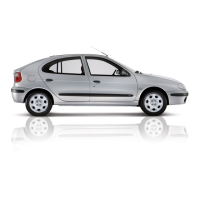Do you have a question about the Renault Megane 2.0 l 16V and is the answer not in the manual?
Using the vehicle's key and remote control for locking and unlocking doors.
Instructions for opening vehicle doors from the outside and inside.
Information on the vehicle's engine immobiliser system and its indicator light.
Guidelines for correct seat belt usage and adjustment for maximum protection.
Explanation of seat belt pretensioners, force limiters, and airbags.
Regulations and recommendations for child restraint systems and safe child transport.
Guidelines for the initial running-in period for petrol and diesel engines.
Procedures for starting and stopping the vehicle's engine under various conditions.
Tips for reducing fuel consumption and emissions through maintenance and driving style.
Explanation of the tyre pressure monitoring system and its operation.
How the ABS system enhances safety during braking.
How the emergency braking assistance system reduces stopping distances.
Information on the ESP system for maintaining vehicle control in critical driving.
Functionality of the traction control system to prevent skidding.
Operating the automatic gearbox, including selector lever positions and driving modes.
How to check and read the engine oil level via the instrument panel and dipstick.
Information on engine oil change frequency, grade, and capacity.
Checking and topping up essential fluid levels like power steering and coolant.
Step-by-step guide on how to change a vehicle wheel.
Essential information on tyre safety, maintenance, and replacement.
Tyre inflation pressures, incorrect pressures, and tyre replacement guidelines.
Information on fuse box, identifying fuses, and replacing them.
Procedures for handling battery incidents and avoiding sparks.
Instructions and precautions for towing the vehicle.
Troubleshooting common operating incidents and their remedial actions.
| Brand | Renault |
|---|---|
| Model | Megane 2.0 l 16V |
| Category | Automobile |
| Language | English |











